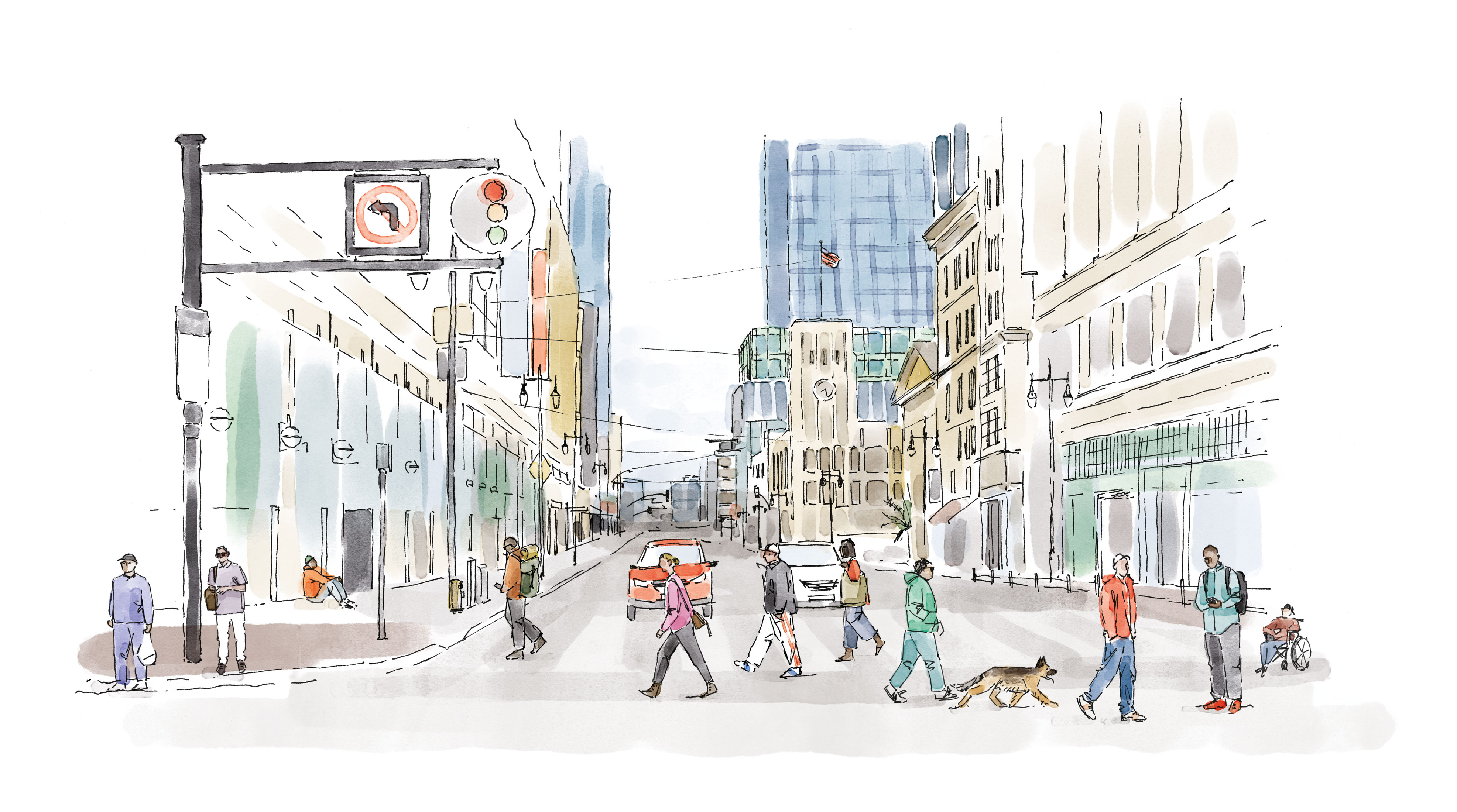
Breaking the cycle of homelessness in San Francisco
In San Francisco, approximately 20,000 people—including children, veterans, and seniors—will face homelessness this year, with communities of color disproportionately affected. That’s more people than can fit in the Chase Center.
San Francisco also grapples with the ongoing opioid epidemic, with fentanyl at the center. Since 2021, synthetic opioids like fentanyl have been involved in two-thirds of overdose deaths in the U.S.7 Fentanyl, which is 50 times more potent than heroin, has driven a surge in overdose deaths, regardless of state drug policies.8 In 2023, the City saw its deadliest year for overdoses, primarily due to fentanyl. Homeless communities and people of color have suffered the most, as gaps in healthcare, housing, and addiction treatment leave them especially vulnerable. Communities experiencing homelessness and communities of color have been especially affected, as they face gaps in healthcare, housing, and addiction treatment services that heighten their vulnerability. For Black residents in particular, the overdose death rate was nearly 400 per 100,000 in 2022—four to five times higher than for White and Hispanic/Latino residents, and 40 times higher than for Asian residents.9
In addition, San Francisco’s homelessness response is affected by State and federal actions. A few policies and rulings are central to San Francisco’s homelessness response. They have provided City government with more latitude than previously, and it is incumbent on any mayor to provide clear guidance about how they intend to interpret and act on them.
- Proposition 47 (Prop 47): Reclassification of felonies to misdemeanors for drug possession. Passed in 2014, this measure downgraded certain drug offenses from felonies to misdemeanors to focus on treatment and reduce incarceration.10 However, a shortage of treatment beds and sober housing keeps many—especially people experiencing homelessness—from accessing help. Local governments must implement these policies, but the resources and behavioral health investments allocated by the state so far haven’t produced meaningful changes, such as more treatment beds or sober recovery options. The era of mass incarceration was a deeply harmful policy that disproportionately devastated communities of color. Similarly, the failure to deliver effective drug treatment locally since Proposition 47 also has been a profound failure.
- Community Assistance, Recovery, and Empowerment (CARE) Court: Alternative mental health court program. Passed in 2022, CARE Court allows families and first responders to request court-ordered care for people with severe mental health disorders, including housing and treatment. San Francisco, one of the first counties to pilot this system, has been slow to make progress. Despite estimates suggesting that 1,000 to 2,000 people are eligible, only five court-ordered treatment plans have been issued, even after the Department of Public Health spent $1.5 million on the program. CARE Court offers a humane alternative to punitive measures, but better implementation is needed for it to succeed.11
- Senate Bill 43 (SB43): Conservatorship expansion. In 2023, SB43 expanded the legal definition of “gravely disabled” to include people with severe substance use or co-occurring mental health disorders who cannot meet basic survival needs.12 This law allows a court-appointed conservator to compel someone to receive treatment. While designed to protect vulnerable individuals, it raises ethical concerns as Black and Latino communities, already disproportionately affected by interventions, could be further marginalized. For SB43 to be both effective and fair, the city must balance civil liberties with providing support to those in need.
- Grants Pass v. Johnson: Ban on encampments. In 2024, the U.S. Supreme Court overturned a ruling that protected unhoused people from being punished for sleeping in public when no shelters were available.13 Since this ruling, San Francisco and other cities have resumed clearing encampments. However, without adequate shelter and treatment options, the city risks repeating a damaging cycle of displacement, detention, and release, which fails to address the root causes of homelessness. Residents deserve safe public spaces, and unhoused people deserve care. Both goals can be achieved through a balanced, long-term approach.
This report outlines specific management actions to make homelessness rare, brief, and one-time, guided by the following principles:
- Focus on those who need care. Our homeless response system is too complex for people trying to access care and for those providing it. As we redesign the system, we need to prioritize more effective care, as opposed to pursuing a political agenda.
- Lead with an equity lens. Communities of color are disproportionately affected by homelessness and often face additional barriers in accessing resources. As we work to improve the homelessness response system, racial equity must be a guiding principle, ensuring that policies and practices address historic and systemic disparities and create fairer outcomes for all.
- Balance the needs of the broader community. Residents and businesses deserve safe neighborhoods, healthy public spaces, and responsible use of taxpayer funds. Our homelessness response must reflect this balance.
- Make tough decisions. City government must be empowered to make the difficult but necessary choices to effectively address homelessness. This includes decisions on governance, resource allocation, and accountability.
- Act, even if the solution isn’t perfect. For too long, waiting for the perfect solution has led to inaction, leaving people on the streets. Safe shelter is better than a tent outside. We must prioritize action over endless debate.
- Pursue lasting solutions, not short-term fixes. Our efforts must address root causes to avoid applying temporary band-aids. While some encampments may need to close for health or safety reasons, only real shelter, housing, and treatment solutions will stop them from returning. We need to break the cycle of homelessness and poverty by providing more housing and shelter, better treatment, meaningful workforce pathways, safe environments and by advancing racial justice.
The City's response to homelessness involves a complex network of City departments, service providers, healthcare professionals, housing developers, and community stakeholders. Despite the best intentions, this well-resourced system is hampered by fragmentation, understaffing, and antiquated systems and procedures. Although the exact amount spent on homelessness is unclear, the City and County of San Francisco alone allocated $1–2 billion in fiscal year 2023–24. Even with this significant investment, many people continue to fall through the cracks due to poor coordination and administrative delays.
Debates center on the division of responsibilities between the City and its contracted service providers. Which services make sense to outsource versus manage within the City? How can improved coordination, partnership, or consolidation within this network enhance efficiency and outcomes? What structural changes are necessary to unify the City's homelessness response?
This report addresses these questions and offers a road map for mayoral administrations to build a better system that delivers lasting, demonstrable results for San Francisco's homeless population.
[6] Kevin Fagan, “Homelessness Is S.F.’s Top Challenge—That’s Obvious, but S.F. Chronicle Poll Reveals Unexpected Views,” San Francisco Chronicle, 17 Sept. 2022, www.sfchronicle.com/sf/article/sfnext-poll-homelessness-crisis-17442518.php.
[7] "Fentanyl Overdose Deaths," New York Times, 27 Sept. 2024, www.nytimes.com/interactive/2024/09/27/opinion/fentanyl-overdose-deaths.html.
[8] Ibid.
[9] Yoohyun Jung, "Tracking San Francisco's Drug Overdose Epidemic," San Francisco Chronicle, 18 Aug. 2023, www.sfchronicle.com/projects/san-francisco-drug-overdose-deaths/. ; "Unintentional drug overdose death rate by race or ethnicity," City and County of San Francisco.
[10] "State Leaders Announce Ballot Measure to Crack Down on Property Crime and Fentanyl," Office of Governor Gavin Newsom, 1 July 2024.
[11] Dustin Gardiner, "'Desperate' Families See Potential in S.F.'s New Mental Health Court but Few Helped So Far," San Francisco Chronicle, 2 Oct. 2023.
[12] "San Francisco Prepared to Implement New Conservatorship Law to Help People Struggling with Severe Substance Use Disorder," City and County of San Francisco, 7 Dec. 2023, www.sf.gov/news/san-francisco-prepared-implement-new-conservatorship-law-help-people-struggling-severe.
[13] “U.S. Supreme Court Overturns Grants Pass v. Johnson Ruling," ACLU of Alaska, 28 June 2024, www.acluak.org/en/press-releases/us-supreme-court-overturns-grants-pass-v-johnson-ruling.

